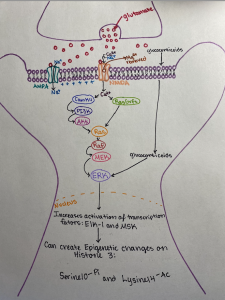Introduction:
Anxiety can be characterized by feelings of nervousness, fear, and stress. Having some anxiety in everyday life is normal and can be positive, but when these feelings interfere with typical daily activities is when this can be an issue. Anxiety disorders occur in 18.1% of the United States population, which is why doing research to improve the lives of many Americans is essential. Depending on the history of someone battling with anxiety, anxiety disorders can be characterized in many ways. In general, most people with anxiety have overactive brain stimulation due to inappropriate glutamate/GABA control. Glutamate activates neurons, while GABA inhibits neurons. Thus, the neurons either are being stimulated by too much glutamate or that there is not enough GABA in the brain.
Who is at risk for anxiety?
Many factors contribute to the likelihood of developing an anxiety disorder. People who have anxious tendencies are at risk for anxiety, as well as people who have experienced past traumatic events. Traumatic events can include sexual assault, combat, natural disasters, serious injuries, and etc. However, trauma is processed by every person differently, which is why some people who have experienced trauma have anxiety disorders.
Brain structures:
Many brain structures can be impacted in anxiety disorders, such as the dentate gyrus, supra-mammillary area, and amygdala. The dentate gyrus can be considered a part of the hippocampus. The hippocampus is responsible for learning and memory, while the dentate gyrus is specifically responsible for episodic memory. Episodic memory is the ability to remember and almost re-live events from someone’s past experiences.
Episodic memory and stress:
Stress can increase glucocorticoids. Glucocorticoids can help to form stronger memories in the hippocampus, specifically the dentate gyrus by upregulating the NMDA/ERK pathway, which is responsible for memory formation.
NMDA/ERK pathway:

AMPA and NMDA are receptors on neurons that bind glutamate to “excite the cell.” In Figure 1, AMPA receptors can open when glutamate binds to depolarize the cell and can help NMDA receptors opening by depolarizing the membrane. Once NMDA binds two glutamate neurotransmitters and removes the magnesium block, this receptor allows sodium and calcium to enter the cell. Calcium activates CamKII and RasGrfs, which both ultimately activate Ras, a kinase upstream of MAPK/ERK.
Ras phosphorylates Raf, which phosphorylates MEK, which phosphorylates MAPK/ERK. When stressed, the body also releases the hormone glucocorticoids, which can bind to a scaffolding protein and increase the activation of MAPK/ERK. The activation of this pathway increases the activation of Elk-1 and MSK, which both function to increase memory formation and consolidation in the dentate gyrus. Also, the combination of MAPK/ERK bound to glucocorticoids increases the likelihood of epigenetic changes on histone 3 in the DNA from stress, which include phosphorylating serine 10 and acetylating lysine 14 in the dentate gyrus. This modification can increase the expression of intermediate early genes (IEG).
Intermediate early genes:
IEGs induce the transcription of c-Fos and Erg-1 to increase and strengthen memory formation. Overexpressing IEGs from experiencing prolonged stress can increase the likelihood of having anxiety due to increasing the amount of stressful memories and making these memories more vivid. However, exciting research in some antidepressants can decrease histone modifications from stressful events as seen in mice studies.
GABA:
Also, another exciting direction in research is looking at GABA in anxiety. Having too little GABA can reduce the neuron’s ability to “quiet down” to avoid vivid and recurring stressful memories that cause distress. In order to increase GABAergic control, some researchers have found that exercise increases the expression of GAD (GABA synthesizing enzyme) after long-term exercise in rats. In rats, the researchers also found that there was reduced activation of the MAPK/ERK pathway that increases the expression of IEGs, thus reducing anxiety symptoms.
So now what?
Research has shown that various medications and even exercise can decrease the expression of IEGs to reduce stressful memory formation and consultation in order to better alleviate symptoms of anxiety disorders. More research needs to be done in order to better treat those with anxiety disorders to return to typical daily activities to improve their quality of life.
Sources:
- https://www.psychiatry.org/patients-families/anxiety-disorders/what-are-anxiety-disorders
- https://adaa.org/understanding-anxiety/facts-statistics
- https://www.nimh.nih.gov/health/topics/anxiety-disorders
- https://www.sciencedirect.com/science/article/pii/B9780128037843000202
- https://www.sciencedirect.com/science/article/abs/pii/B9780123864918000037
- https://onlinelibrary.wiley.com/doi/full/10.1111/j.1471-4159.2006.04208.x
- https://journals.physiology.org/doi/full/10.1152/physrev.00028.2011
- https://www.frontiersin.org/articles/10.3389/fpsyt.2014.00005/full